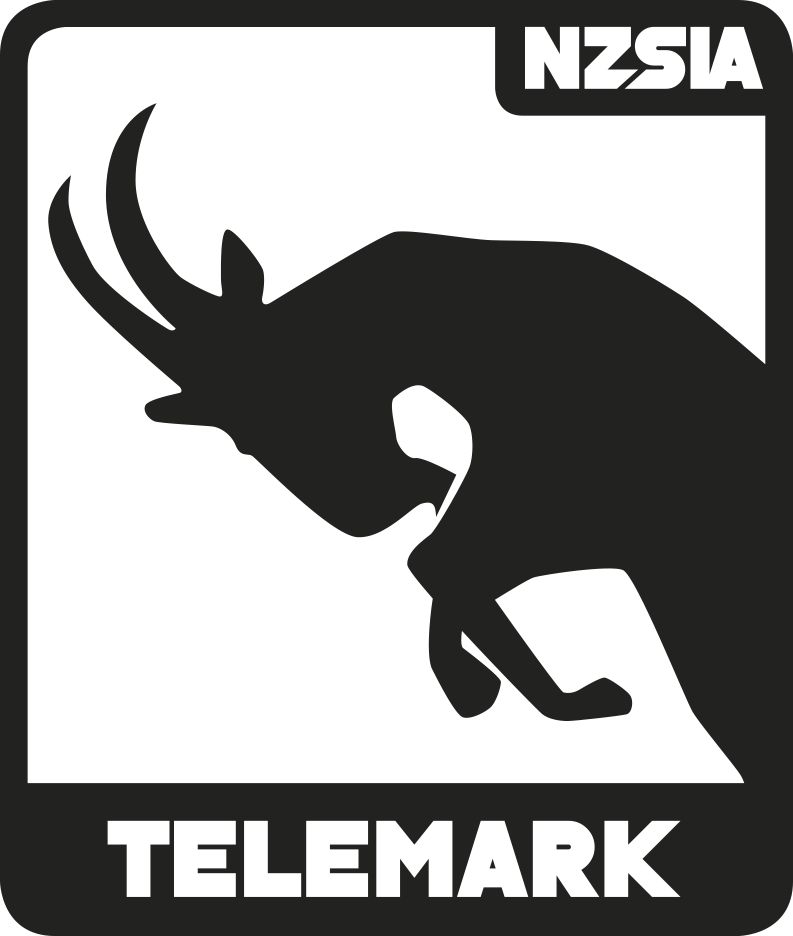Here we talk about how gravity, friction, and snow reaction forces influence a telemark skier’s movement and balance. This section highlights how these external forces interact with the skier’s mass, centre of gravity, and base of support, particularly within the unique demands of the telemark stance. It explains the principles behind managing pressure, understanding centripetal and resultant forces, and maintaining balance while turning. The chapter also introduces platform and steering angles, which help determine grip and turn shape.
External Forces
Sir Isaac Newton identified a set of laws that involve forces and acceleration, momentum, and inertia.
The first law states that an object in a state of motion tends to stay in that state of motion unless an external force acts upon it. This is the definition of inertia. In a straight run, a telemark skier will continue to go straight unless an external force causes them to turn. A skier will not change direction unless a force acts upon them. This means that the skis need to interact with the snow so that the snow can push the skier around the turn.
The second law defines the relationship between mass, force, and acceleration. This is represented by F=ma. This states that the direction of the force is the same as the direction of the acceleration. An example is a telemark skier initiating a turn by engaging the inside edge of the lead ski while weighting the back ski appropriately. This causes the snow to push against the inside edge of the lead ski, directing the skier into the turn.
The third law states that every action has an equal and opposite reaction, meaning all forces involve two objects, and the force acts with equal strength but in opposite directions on both. In a telemark turn, the two objects are the telemark skier (and telemark skis) and the snow. The force from the snow pushes on the ski, causing the skier to change direction. The telemark skier responds with muscular tension to resist and balance against that force while maintaining the lead-change position.
- “Without G1, the skier would not be in motion” is an example of Newton’s first law.
- “The skier accelerates in the direction of G1” is an example of Newton’s second law.
- “The snow pushes back at the skier with an equal amount and in an opposite direction of G2” is an example of Newton’s third law.
Note that the steeper the slope, the larger G1 will become; therefore, the skier will accelerate more rapidly.
As a ski is tipped up on edge in a telemark turn, it penetrates the snow, and the snow presses back on the ski, causing it to bend. The force from the snow pushing on the ski causes the skier to change direction. If we imagine a turn as a portion of a circle, the force acting on the skis is directed towards the centre point of the turn or the axis of rotation. This is called centripetal force and is responsible and essential for turning.
Centripetal and Resultant Force
In telemark skiing, centripetal force refers to the force that acts on a skier as they navigate a curved path or turn. When a telemark skier initiates a turn, they experience a change in direction, and centripetal force is responsible for pulling or guiding them toward the centre of the turn. This force is directed inward, perpendicular to the skier’s velocity, and it is necessary to keep the skier moving along the curved trajectory.
Centripetal force is generated through a combination of factors, including the carving of the skis into the snow, the angulation of the skier’s body, and the inclination of the skier’s upper body toward the centre of the turn. Proper technique, lead-change timing, and weight distribution play crucial roles in maximizing centripetal force and allowing the skier to maintain control and stability while executing turns on the slopes.
On the other hand, centrifugal (resultant) force is often perceived as an outward force experienced by objects moving in a curved path, as if pushing them away from the centre of the curve. However, it’s essential to note that centrifugal force is not a real force but rather a resultant force experienced in a non-inertial (accelerating) reference frame.
In the context of telemark skiing, when a skier makes a turn, they may feel as if they are being pushed outward due to centrifugal force. However, this feeling is a result of inertia—the tendency of objects to continue moving in a straight line unless acted upon by an external force. The skier’s body wants to continue moving in a straight line, but the centripetal force provided by the factors mentioned earlier causes the skier to move in a curved path. Thus, centrifugal force can be understood as a perceived force resulting from inertia resisting the change in direction caused by the centripetal force.
Any change in speed or size of the turn will change the amount of resultant force experienced by the skier. For example, two ways to increase resultant force acting on the skier would be to either go faster or tighten the radius of the turn.
Understanding these concepts is essential for telemark skiers as it helps them optimize their movements and navigate turns effectively, contributing to a smoother and more efficient skiing experience.


